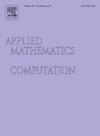图的局部不规则性的一个新问题
IF 3.4
2区 数学
Q1 MATHEMATICS, APPLIED
引用次数: 0
摘要
如果图/多图G的每条边的顶点具有不同的度数,则该图/多图G是局部不规则的。G的局部不规则边着色是它的边着色,其性质是每一种着色都能导出G的一个局部不规则子(多)图;如果G存在这样的着色,则以这种方式着色G的最小颜色数是G的局部不规则色指数(用lir(G)表示)。我们提出以下新问题:给定一个不同于K2或K3的连通图G,使得到的多图在最多使用两种颜色的情况下是局部不规则边可着色(没有单色多边)的G的最小边数是多少?这个问题与几个开放猜想(如图和2-多图的局部不规则猜想,或(2,2)-猜想)和其他类似的边着色概念密切相关。我们给出了几个图类:路径、环、树、完全图、完全k部图、分裂图和环的幂的这个问题的解。我们对完全k部图(k>1)和循环幂(非完全图)的解表明,在这种情况下,局部不规则色指数等于2。我们还考虑了仙人掌的特殊科的这一问题,并证明了其加倍生成局部不规则可着色多图的最小边数不仅对局部不规则不可着色仙人掌没有常数上界。本文章由计算机程序翻译,如有差异,请以英文原文为准。
On a new problem about the local irregularity of graphs
A graph/multigraph is locally irregular if endvertices of every its edge possess different degrees. The locally irregular edge coloring of is its edge coloring with the property that every color induces a locally irregular sub(multi)graph of ; if such a coloring of exists, the minimum number of colors to color in this way is the locally irregular chromatic index of (denoted by ). We state the following new problem: given a connected graph distinct from or , what is the minimum number of edges of to be doubled such that the resulting multigraph is locally irregular edge colorable (with no monochromatic multiedges) using at most two colors? This problem is closely related to several open conjectures (like the Local Irregularity Conjecture for graphs and 2-multigraphs, or (2, 2)-Conjecture) and other similar edge coloring concepts. We present the solution of this problem for several graph classes: paths, cycles, trees, complete graphs, complete -partite graphs, split graphs and powers of cycles. Our solution for complete -partite graphs () and powers of cycles (which are not complete graphs) shows that, in this case, the locally irregular chromatic index equals 2. We also consider this problem for special families of cacti and prove that the minimum number of edges in a graph whose doubling yields an local irregularly colorable multigraph does not have a constant upper bound not only for locally irregular uncolorable cacti.
求助全文
通过发布文献求助,成功后即可免费获取论文全文。
去求助
来源期刊
CiteScore
7.90
自引率
10.00%
发文量
755
审稿时长
36 days
期刊介绍:
Applied Mathematics and Computation addresses work at the interface between applied mathematics, numerical computation, and applications of systems – oriented ideas to the physical, biological, social, and behavioral sciences, and emphasizes papers of a computational nature focusing on new algorithms, their analysis and numerical results.
In addition to presenting research papers, Applied Mathematics and Computation publishes review articles and single–topics issues.

 求助内容:
求助内容: 应助结果提醒方式:
应助结果提醒方式:


